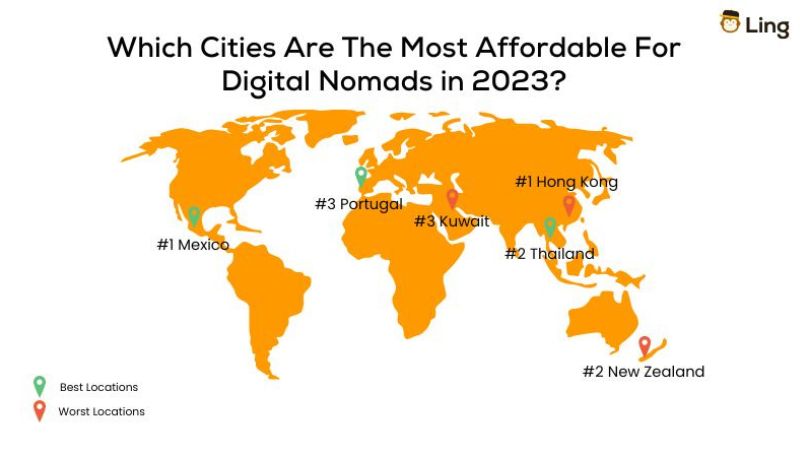At this point, most people know and understand what digital nomads are and the expected lifestyle that comes along with that. But some may be wondering if digital nomadism was just a pandemic trend. Let’s take a look at digital nomad statistics 2023 and find out if this movement is sticking around.
Will Digital Nomadism Continue To Rise In 2023?

The digital nomad statistics 2023 point to yes. With remote work becoming more accessible and acceptable among institutions that have historically responded negatively to it, this will allow for companies to expand international teams with people who have the necessary skills on the ground.
Here are some talking points that indicate the trendy digital nomad movement will only continue to grow in popularity.
Fears About Lower Productivity Are Unfounded
When many workplaces switched to remote work during the Covid pandemic, there was a fear that at home work environments would negatively impact productivity and bottom lines. Instead, 83% of C-level executives reported that remote work led to increased successes within their businesses.
Another survey conducted by FlexJobs revealed that over 50% of 2,000 participants experienced increased levels of productivity while working remotely.
Access To Technology Will Fuel The Digital Nomad Trend In 2023
The demand for remote work software saw a huge increase. 72% of executives surveyed said they plan to implement and invest in virtual collaboration tools. Also, the market saw a 51% increase in SaaS software use over a one year period.
With access to high speed internet and investment by companies in remote accessible SaaS vs traditional software, digital nomads worldwide will become more mainstream and acceptable.
Workers Are Demanding The Digital Nomad Lifestyle
According to a study conducted by Dr. Francesca Ortegren, there is a movement happening in regards to remote work which will impact digital nomad statistics.
- 63% of surveyed employees prefer working remotely
- 29% of workers don’t plan to return to the office
- 24% of in-office workers don’t feel safe at work
How Many Digital Nomads Are There In 2023?
The term digital nomad didn’t even enter our vernacular until the late 2010s and even as recently as 2018, only 4.8 million people in the United States identified themselves as being a digital nomad. Flashforward to 2023, and digital nomadism is on the rise. There are now over 23.2 million nomads in the United States alone.
In fact, worldwide over 35 million people use “digital nomad” to describe their profession, and this number is only going to increase as demands and workplace desires change. This is evident by 86% of people reporting they would prefer to work remotely if given the opportunity.
Key Digital Nomad Statistics: Demographics 2023

The demographics of digital nomads are constantly changing. For example, in 2020 a whopping 79% of nomads identified as male. Now, female digital nomads make up 48% of this industry.
The age range for a digital nomad is vast, with ages ranging from 17 all the way up to 72 years old. However, the average age of a digital nomad is 34 years of age.
Nomads also tend to be well educated. In fact 90% report having some form of higher education. The majority, 54%, of nomads have at least a bachelor’s degree while more than a third have a PhD.
Seeing as most digital nomads at the moment come from the United States, it’s unsurprising to learn that the majority of nomads identify as caucasians. The top 5 ethnicities working as digital nomads around the world are:
- Europeans/Caucasian
- Asian
- Latin
- African descent
- Indian
Where Do Digital Nomads Want To Live?
Digital nomads want to live in affordable places, with access to technology (notably high speed internet) while maintaining a relatively high standard of living. Places that tend to attract digital nomads have all of the above along with a good digital nomad community.
Which Cities Are The Most Affordable For Digital Nomads in 2023?

The majority of digital nomads will look for affordable places with excellent internet and the potential for adventure. At the moment, 14% of digital nomads report living in Mexico, 11% of nomads are based in Thailand while 8% of nomads are residing in Portugal. This makes the top three destinations for digital nomads:
- Mexico
- Thailand
- Portugal
Looking from the opposite perspective, what are the 3 worst places for digital nomads to live? According to a desirability survey by InterNations, the countries that come out as the bottom choices are, Kuwait, New Zealand, and Hong Kong.
Where Do Digital Nomads Prefer To Work From?
There seem to be coworking spaces popping up everywhere, but it turns out that about 61% of digital nomads actually prefer to work from a home office. This could be in their hotel room, AirBnB, or rented accommodation. This is actually surprising because a large number of digital nomads give off an air of being very social.
How Much Do Digital Nomads Earn?

There’s a plethora of industries that digital nomads work in and many are entrepreneurs as well, so this can factor into salary potential. According to the 2020 MBO report, only 36% of digital nomads report earning an income of over $75,000 USD per year, while a surprising 25% earned less than $25,000.
Flashforward to how much digital nomads make in 2023, and those numbers have changed immensely. 36% now make over $100,000 USD per year. The average income for a digital nomad in 2023 is over $122,000 USD and the median income is $85,000 USD per year.
Pros And Cons Of Being A Digital Nomad In 2023

Pros of Leading a Digital Nomad Lifestyle:
- Dictating your own hours
- Flexibility in how and where you work from
- The opportunity to experience different cultures
- Potential to save more money
- Networking across borders
- Building or finding your own community
- Ability to learn new skills
- Opportunity to learn a new language
Cons of Leading a Digital Nomad Lifestyle:
- Financial uncertainty or insecurities
- Being able to plan for the future
- Unstructured hours and inability to switch off
- Maintaining motivation
- Feelings of loneliness or isolation
- Being able to stay abroad for extended period of time (Visa costs and issues)
- Having to pay for own healthcare/insurance
Top 10 Digital Nomad Statistics You Should Know in 2023



































































